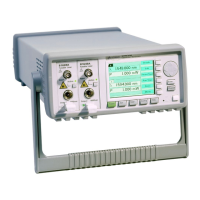8163A/B, 8164A/B, 8166A/B User’s Guide 229
Setting Attenuation and/or Power Levels 8
Figure 138 on page -228shows an absolute power P
SET
of -10 dBm
applied to a DUT. Here:
• A power offset P
Offset
of 0.376 dB is applied to calibrate for losses
between the Attenuator and the DUT.
• An attenuation factor α of 7.656 dB is applied by the Attenuator’s filter.
How to Compensate for Wavelength Dependencies in your test setup
To allow you to compensate for wavelength dependencies in your test
setup, your attenuator module can store an array of up to 1000
wavelength: Offset pairs in a
λ Offset Table.
How to Apply a
λ Offset Table
Select the [Offset (
λ)] parameter to enable or disable the Wavelength
Offset Table <On> or <Off >.
The Menu item <Offset (
λ) > is functionally equivalent to the
[Offset (
λ)] parameter.
Editing the
λ Offset Table
If you have previously characterized the output path:
1 Press the [Menu] softkey.
2Set <Offset (
λ) > to <off >.
Your calibration is valid until there is some change to the optical path
between the Attenuator module and your DUT. Changes to the power
applied to the input of the Attenuator module are detectable by the
integrated powermeter.
For a multi-wavelength DWDM signal, your determined effective
wavelength l effective is valid until there is some change to the signal’s
optical power vs wavelength spectrum.
If either too much, or too little, input power is applied for the Attenuator
to maintain your desired P SET, the Attenuator status display includes
‘Exp’.
Refer to How to Use the Power Control Feature on page 78 for
information about compensating for changes in input power.

